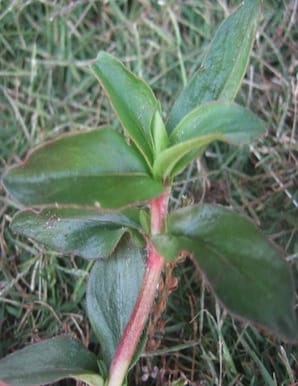Info taken from the publication Virginia Buttonweed Identification and Control in Turfgrass by Patrick McCullough and Jialin Yu, UGA Department of Crop and Soil Sciences
Virginia buttonweed (Diodia virginiana L.) is a troublesome broadleaf weed in turfgrass throughout the southeastern United States. Virginia buttonweed is a deep-rooted perennial with prostrate or spreading branches. It usually proliferates in moist to wet areas and can tolerate mowing heights as low as one-half inch. The species is a member of the Rubiaceae family and is found from New Jersey, west to Missouri and south into the Gulf Coast states.
Virginia buttonweed leaves are slightly thickened, opposite without petioles and slightly rough along the margins (Picture 1). Leaves are green on the upper surface, light green on the lower surface and often have a mottled yellow mosaic appearance caused by a virus that commonly infects foliage (Picture 2). Branched stems are occasionally hairy (Picture 3) and reproduction occurs via seeds, roots or stem fragments. Flowers are white with four star-shaped petals, which sometimes have pink streaks in the center and two sepals. Fruit are green, elliptically shaped, hairy and ridged.
For info on managing this weed:
Or see sections of the publication on:
